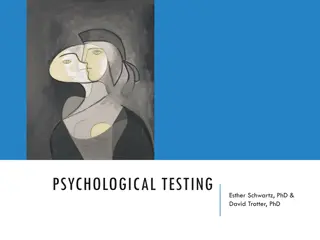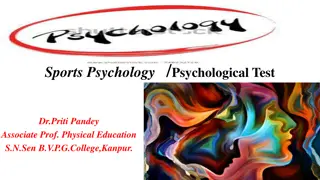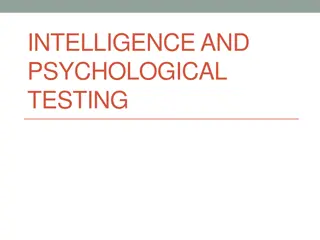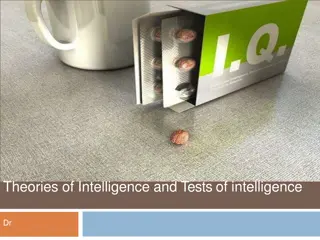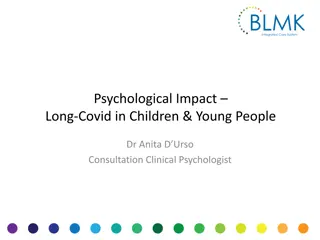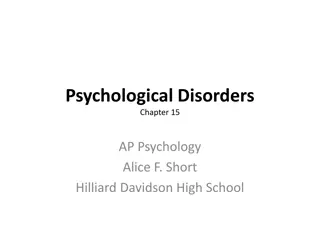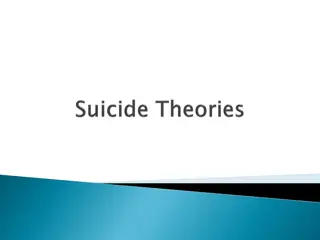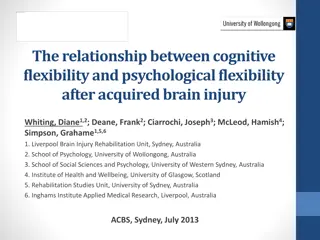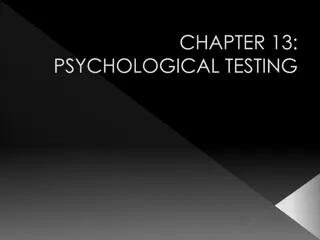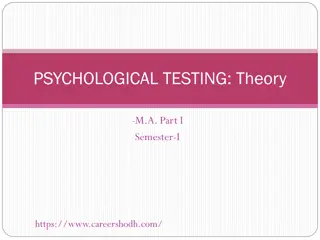Understanding Intelligence and Intelligence Testing: A Psychological Perspective
Explore the concept of intelligence, its measurement, and classical theories through the lens of psychology. Learn about the different perspectives and factors that shape our understanding of intelligence.
Download Presentation

Please find below an Image/Link to download the presentation.
The content on the website is provided AS IS for your information and personal use only. It may not be sold, licensed, or shared on other websites without obtaining consent from the author. Download presentation by click this link. If you encounter any issues during the download, it is possible that the publisher has removed the file from their server.
E N D
Presentation Transcript
MEASUREMENT OF INTELLIGENCE AND USES OF INTELLIGENCE TESTS Degree Course (Three Years) Psychology Honours B. A. Part I Honours Paper I : General Psychology Unit 8 by Dr. Ranjan Kumar Ph. D ; M Phil ; PGDGC Assistant Professor of Psychology Ram Ratan Singh College, Mokama Patliputra University, Patna
MEASUREMENT OF INTELLIGENCE AND USES OF INTELLIGENCE TESTS Presented by Dr. Ranjan Kumar Ph. D in Clinical Psychology (RINPAS, Ranchi) M. Phil. in Medical & Social Psychology (RINPAS, Ranchi) PG Diploma in Guidance & Counselling (RIE,NCERT,BBSR) Assistant Professor of Psychology Ram Ratan Singh College, Mokama Patliputra University, Patna
What is intelligence? A loaded question . . . Ability to understand, reason and perceive ; quickness in learning; mental alertness; ability to grasp relationships etc Buddhi, pratibha, prajna, medha, dhi,chaturya are terms used in Indian context The capacity to profit from experience and to go beyond the given
Intelligence is what intelligence test measures(Alfred Binet,1904) The ability to judge well, to understand well and to reason well (Binet & Simon,1905) The aggregate capacity of the individual to act purposefully, to think rationally and to deal effectively with the environment(David Wechsler,1939) The ability or skill to solve problems or fashion products which are valued within one or more cultural settings(Howard Gardner,1986)
Intelligence comprises the mental abilities necessary for adaptation to, as well as shaping and selection of, any environmental context (Robert Sternberg,1997)
Some Classical Theories of Intelligence Thorndike (1911) proposed that there are four types of intelligence viz, comprehension, arithmetic, vocabulary and ability to follow direction
Spearmans two-factor theory Intellectual ability consists of two factors g factor and s factor General factor is universal in nature, found in all humans. It is the innate ability acquired at birth through heredity Specific factor determines individual differences which is unique to individuals e. g clerical, mathematical, musical intelligence
His theory was published in the American Journal of Psychology in 1927 Based on the observation that persons who excel on one type of intellectual task(e.g. math)tends also to perform well on others(e. g. defining words) He noted that when individuals are given ability tests tapping a variety of contents(e.g. numerical problems and visuo-spatial designs) the resulting test scores consistently yielded positive intercorrelation.
Thurstones theory of Primary mental Abilities(1938) Intelligence consists of seven major factors which are relatively independent of the others Verbal comprehension Numerical Spatial visualisation Perceptual speed Memory Reasoning Word/verbal fluency
Raymond Cattels Fluid and Crystallysed intelligence Proposed that there are two g factors gf for fluid intelligence and gc for crystallised intelligence Fluid intelligence includes the ability to think creatively, to reason abstractly, to make inferences from data and to understand relationships Measured by analogy ,working memory, concept formation and classification problems Strongly influenced by heredity Reflects the biological integrity of the CNS
Crystallized intelligence includes what a person learns and retains from experience and is strongly influenced by environment Reflects the influence of formal education and acculturation Tests of vocabulary and general information and academic achievement can be used to measure g c Fluid intelligence peaks in young adolescence and young adulthood and declines at an early age than crystallised intelligence gc can be increased throughout the lifespan via formal education , personal reading and socialisation
Intelligence testing in retrospect Intelligence testing in retrospect British scientist Sir Francis Galton establishes first anthropometric lab in 1884 to measure intelligence (head circumference, reaction time strength and movement, visual discrimination, breathing capacity) Father of mental testing James McKeen Cattell coined the term mental test Both reduced intelligence to sensory , perceptual and motor processes
First systematic attempt by Alfred Binet and his student T Simon in 1904 First test of intelligence consisting of 30 items came out in 1905 to identify children with special needs(Binet- Simon test) Items ranged from the ability to touch one s ear when asked, to draw designs from memory and define abstract concepts. Core of intelligence consists of more complex mental processes such as memory, imagery, comprehension and judgment
The Binet-Simon test was revised and expanded in 1908 where he introduced the concept of mental age Another version came out in 1911 William Stern introduced the concept of mental quotient in 1912(MA/CA)
First US intelligence test introduced by Lewis Terman in 1916 Revision of Binet-Simon test at Stanford University Stanford-Binet test Currently 4th revision of SB test in use Converted MQ to intelligence quotient (MA/CA x100)
1916 Stanford-Binet Sample Items for 12 yr olds Practical Problem Solving Vocabulary Grammar 1. 45.Sportive. 80.Exaltation. 92. Theosophy Orange. Interpretation Similarities Memory Snake, cow, sparrow 3-1-8-7-9 Book, teacher, newspaper Wool, cotton, leather 6-9-4-8-2 5-2-9-6-1
David Wechsler criticized SB test and he introduced Wechsler-Belluve Intelligence scale form(WBI)in 1939 that yields separate verbal, performance and global scale Constructed at New York University medical centre and Belluve Psychiatric Hospital He introduced Deviation IQ Developed Verbal and Performance IQ scores and normal distribution Most widely used intelligence scales in the world at present
Types of IQ Ratio IQ First type of IQ Stern (1938) IQ = MA/CA x 100 Same IQ has different meanings at different ages Not used as often now Deviation IQ A type of standard score Mean = 100, SD = 15/16 Compares IQ to same age peers Normal distribution WISC uses this
Psychological testing A psychological test is an objective and standardised measure of a sample of behaviour (A Anastasi) A psychological test is an organised succession of stimuli designed to measure quantitatively or to evaluate qualitatively some mental process or characteristics The chief characteristics of a psychological tests are objectivity, standardization , reliability and validity Psychological tests are classified on the basis of the psychological variable that is being tested. Psychological tests include intelligence tests, interest tests, attitude tests, aptitude tests, achievement tests, personality tests etc.
Types of Intelligence tests Intelligence tests are broadly divided into two types based on administrative condition Group tests and individual tests Based on the nature of tests, intelligence tests are divided into Verbal Nonverbal and Performance Based on the time limit they are divided into Speed tests and Power tests
Individual test Individual test Administered to one person at a time Time consuming Allows the examiner to establish proper rapport Help in diagnosis and remediation of individual learning difficulties Standardised on relatively small samples Group test Group test Administered on a mass scale Less time-consuming Minimal role of the examiner Used for mass screening Standardised on ultra large samples
Verbal ,Non-verbal and Performance tests Verbal test demands understanding of written words Can only be administered to literates e. g. Verbal Adult Intelligence scale (VAIS) Non verbal tests Use picture or illustration as items e. g Raven s Progressive Matrices Performance tests are made up of certain concrete tasks e.g. Koh s Block Design Test, WAPIS
In speed tests there is a prescribed time limit to complete the test, Individual differences depend entirely on the speed of performance e. g. WAPIS In power tests there is no time limit to finish the test. A pure power test has a time limit long enough to permit everyone to attempt all items e. g Raven s Progressive Matrices
Wechslers Intelligence tests Best standardised and most widely used intelligence tests in the world Designed in 1939 by David Wechsler There are three types of Wechsler s Intelligence tests WPPSI-Wechsler s Preschool and Primary Scale of Intelligence for the age range of 4-6.5 years WISC-IV-Wechsler s Intelligence Scale for Children for the age range of 6-15 years WAIS-III-Wechsler s Adult intelligence Scale (16-24 Years) WAPIS-Wechsler s Adult Performance Intelligence Scale (15- 44 years) is the Indian adaptation of WAIS scale standardised by Prabha Ramalingaswamy in 1974
WAIS The first was Wechsler-Belluve Intelligence Scale with age range 16-64 years Replaced in 1955 by the Wechsler s Adult Intelligence Scale (WAIS) 1981 Revision is WAIS-R 1997 revision is currently in use known as WAIS-III It consists of 11 subtests(6 Verbal and 5 performance tests) It gives full scale IQ score, Performance and Verbal IQ score If the difference between VQ and PQ is more than 20 points brain dysfunction is indicated Interpretation by converting raw score into scaled score(gives IQ)
Verbal Scales Information Digit span Vocabulary Arithmetic Comprehension Similarities
Performance scales Picture completion Picture arrangement Block design Digit symbol Object assembly
Hold test and Dont hold test Hold tests -don t deteriorate with age- vocabulary information object assembly, picture completion Don t hold tests- deteriorate with age- Digit symbol Digit span Similarities Block design
DQ =H-DH X 100/H where DQ=BRAIN DYSFUNCTION H=Hold test DH=Don t hold test
WISC First published in 1949 Revised in 1974 known as WISC-R WISC-IV currently in use Administration time varies from 1-3 hours Must be trained in order to administer complicated rules
Provides Full Scale IQ--Global estimate of child s general intellectual capacity/potential/level of cognitive ability and the relative standing compared to the normative population Verbal Comprehension Index verbal reasoning skills Perceptual Reasoning Index nonverbal reasoning skills Working Memory ability to attend to and hold information in memory to formulate responses Processing Speed speed of processing information Uses the deviation IQ (mean = 100, SD = 15) WISC standardised on Indian population by Malin known as Malin s Intelligence Scale for Indian Children(MISIC) for the age group of 6-15 years-15 subtests
WAPIS Performance part of WAIS adopted for Indian population by Prabharamalingaswamy in 1974 Performance scale consists of Picture completion(26 cards) Picture arrangement(9 items) Block design (10 items) Digit symbol(90 items) Object assembly(4 items)
Indicators of Wechslers Tests SUBTEST HIGH SCORE LOW SCORE INFORMATION OBSESSIVE-COMPULSIVES CHRONIC SCHIZOPHRENICS DIGIT SPAN SCHIZOIDS DEPRESSIVE PSYCHOTICS PICTURE ARRANGEMENT NARCISSITIC CHARACTER DISORDERS PARANOID CONDITIONS BLOCK DESIGN SCHIZOPHRENICS DEPRESSIVES OBJECT ASSEMBLY DETERIORATED SCHIZOPHRENICS ORGANICITY, DEPRESSION DIGIT SYMBOL OBSESSIVES, MANICS DEPRESSIVE NEUROTICS ARITHMETIC OBSESSIVE COMPULSIVES NARCISSITIC PATIENTS, ORGANICS
Bhatias Battery of Performance Intelligence Test Chander Mohan Bhatia developed this test For illiterates most amenable Consists of 5 subtests Block Design(10 cards) Pass along test(8 patterns) Pattern drawing test(8 patterns) Immediate memory span(sounds/digits) Picture construction test (5 items)
Verbal tests Binet- Kulakshetra Test(3-22 years) Revised and adapted for Indian conditions Gives pattern analysis for 7 primary abilities namely language, memory , conceptual thinking, reasoning, numerical reasoning, visuo-motor coordination and social intelligence Verbal Adult Intelligence Scale (VAIS) ,Indian adaptation of WAIS Verbal part Consists of information , arithmetic, digit span and comprehension subtests
Seguin form board test French physician Seguin devised it It is a performance test used mostly with children(3-11 years) and illiterates J Bharath Raj and SK Goel derived the norms for Indian population Consists of a wooden board in which the individual is required to insert 10 variously shaped blocks in the corresponding recesses as quickly as possible
Differential Ability Tests Developed by Elliott Used for analyzing and diagnosing children s learning difficulties To identify, select and classify children(2.5 to 17 years ) with learning disabilities
Consists of 20 subtests including 12 core subtests, 5 diagnostic subtests and 3 achievement subtests Provide useful information for understanding child s cognitive strengths and weaknesses
Peabody Picture Vocabulary Test Used when testing time is limited or/are subject s reading skills are poor It uses only pictures as test materials Used for age level 2.5 to 85 years
Tests for hearing handicapped Hiskey-Nebraska Test of learning Aptitude Consists of 12 nonverbal subtests administered with pantomimic directions to deaf children Wechsler s performance subtests can also be used
Tests for visually handicapped Haptic intelligence Scale for Adult Blind Wechsler s verbal subtests can be used for blind and partially sighted Perkin-Binet test of intelligence
Developmental schedules Used with severely retarded children who are not receptive to verbal, nonverbal and performance tests Also used with small children and infants Testing with infants are difficult because of short attention span and greater susceptibility to fatigue
1. Brazelton neonatal behavioral assessment scale Age range is 3 days to 4 weeks Scored on 26 behavioral items and 20 elicited responses including measures of neurological, behavioral and social functioning
2. Bayley Scales of Infant Development Age range-1 to 30 months Consists of 3 parts Mental scale Motor scale Behavioral rating scale
3.McCarty Scales of children abilities Age range-2.5 to 8.5 years Consists of 6 measures of intellectual and motor development Verbal Perceptual performance Quantitative General cognitive Memory and Motor
4.Koffmans Intelligence tests Koffman s Assessment battery for children(K- ABC) designed by A S Koffman and N L Koffman Age range -2.5 to 12.5 years It measures simultaneous and sequential mental processing
Group Intelligence tests Multilevel Group intelligence Tests Used to compare intellectual growth of children over several years 1. Otis-Lennon School Ability Test(OLSAT) 2. Cognitive Ability Test 3. Wonderic Personnel Test
Culture free and culture fair tests Culture free tests are tests yielding scores that are completely independent of all cultural influences Culture fair tests are tests which are fair and appropriate for respondents of all cultures and subcultures e. g Cattell Culture Fair series, Learning Potential Assessment Device, Raven s Progressive Matrices
Ravens Progressive Matrices It is a nonverbal test of observation and clear thinking It consists of 3 matrices(Subtests) 1. Standard progressive matrices(6-80 years) 2. Coloured progressive matrices (5-11 years) 3. Adult progressive matrices for average adults
RPM assesses the two components of g identified by Spearman as educative ability and reproductive ability Educative ability refers to making meaning out of confusion, developing new insights and decision making Reproductive ability involves mastering, recalling and reproducing material which forms a cultural store of explicit, verbalised knowledge




